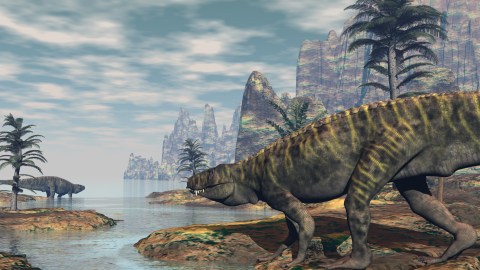Rock study may have just revealed cause of Triassic mass extinction

Credit: Elenarts/Shutterstock
- A new study suggests that the mass extinction that gave dinosaurs the evolutionary upper hand was caused by oceanic oxygen deprivation.
- Using ratios of sulfur isotopes, researchers could estimate changes in ocean oxygen levels in ancient seas.
- The authors suggest a similar mechanism as that which can cause dead zones in oceans today caused a mass extinction.
Living on Earth isn’t always easy. The fossil record is littered with enough mass extinction events to have once made theories that they occur in cycles seem feasible. The “Big Five” events each killed an average of 75 percent of all species alive at the time, with the largest one wiping more than 90 percent of them. While the question of what caused these events is interesting as a curiosity in and of itself, the problem also takes on an existential one, as most people would like to avoid the same fate as the trilobites.
To that end, a team of researchers based out of the UK, China, and Italy have investigated the causes behind one of the most massive die-offs in history. In a new paper published in Science Advances, they suggest a depletion in oxygen as a cause for the event at the end of the Triassic Era 201.3 million years ago.
The mass extinction that ended the Triassic period was a massive die-off that saw somewhere between a quarter and a third of ocean life vanish alongside most large land animals. Plants were not spared a culling either, with perhaps 60 percent of plant species also dying. The event took less than 10,000 years to carry out this morbid work. This remarkable event paved the way for dinosaurs to become the dominant land animal during the Jurassic period, as most of their competition was dead.
Explanations for this event’s cause have ranged from gradual climate change, to asteroid impacts, to rampant volcanism. New evidence suggests that ocean anoxia, the depletion of oxygen supplies in the ocean, played a large role.
The researchers examined the levels of two isotopes of sulfur in rocks that would have been on the seafloor during the extinction event from British Columbia, Sicily, and Northern Ireland. The two isotopes, 32S and 34S, can become trapped in limestone and other rocks and exist at different ratios depending on how much oxygen is in the water around them. By examining the changes in the ratio of the two isotopes in rocks formed at the time, we can know what was happening to oxygen levels in the oceans hundreds of millions of years ago.
The scientists noticed “large spikes” in the ratio of 34S to 32S in the samples from all of the locations, indicative of a substantial fall in the amount of oxygen available. These findings can be applied far beyond the sites the rock samples came from, suggesting that oxygen levels fell across large portions of the globe-spanning superocean, known as Panthalassa, that existed alongside Pangea.
This study isn’t the only one suggesting Ocean anoxia caused the extinction event. A previous study from 2017 reached a similar conclusion by measuring the trace uranium levels in rocks formed at the time. Similarly to the ratio of sulfur isotopes considered above, the amount of uranium in these rocks varies with the amount of oxygen. That study suggests that the low oxygen levels may have lasted 50,000 years after their initial fall, with a full 250,000 years needed before coral reefs could recover.
In the present day, the researchers hypothesize that this anoxia was connected to significant volcanic activity at the time. By releasing massive amounts of greenhouse gasses, this would have both acidified the oceans by increasing their carbon content and lowered their oxygen levels by raising global temperatures, as warm water holds less oxygen overall. Together, these effects can annihilate marine ecosystems. It is known that major volcanic activity was occurring at the time, lending credence to this hypothesis.
It’s a good thing that nothing is causing the oceans to heat up and have lower oxygen levels these days! Oh, wait. Never mind.





